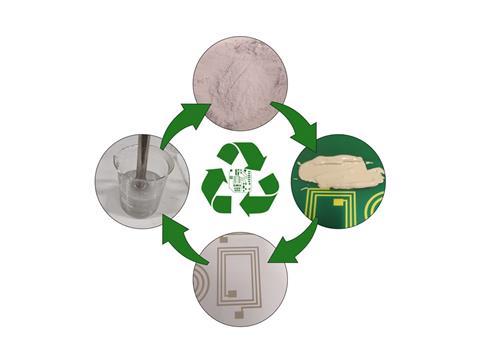
Researchers at Swansea University in Wales have developed a recyclable silver conductive ink which they hope can enable the creation of circular electronics without compromising performance.
While printed electronics can be added to packaging to increase functionality through IoT monitoring and asset tracking, and to create new user experiences for the next generation of technology-savvy consumers, it can make recycling of the packaging material more complex or even impossible.
The new, low-temperature curing ink was developed for screen printing conductive tracks, to provide a route to scale up the technology using commercially available processes.
The key to the technology resides in the conductive particles, giving the opportunity to adjust the formulation to suit different processes and requirements while maintaining recyclability, say the developers. The silver ink can produce conductivities within 75% of conventional silver flake inks and orders of magnitude higher than carbon-based inks often used for their sustainability, the results show.
The ink has been designed to be recovered from a range of different substrates including paper or plastic, and from the product, packaging, and manufacturing waste. A simple and environmentally friendly silver recycling process allows all parts of the packaging to be recycled in a cost-effective way.
During initial testing, 95% of the silver was recovered from uncoated paper and was unchanged by either the printing or recovery process. This means the recovered silver can be remanufactured into new inks without the need for further processing, reducing material costs, securing supply, and creating a closed-loop system for printed electronics, according to the research team.
Alternatively, the electronics could be extracted from the waste stream in a multistep process by means of a release layer, allowing the electronics to be separated from the bulk of the packaging prior to the recovery of the conductive silver.
“We envisage the ink being used in the creation of connected and intelligent packaging, including RFID aerials for IoT monitoring, capacitive touch sensors, sensor interconnects, and illumination in high-value packaging, all without the generation of electronic waste,” said a spokesperson.
The team at the Welsh Centre for Printing at Coating (WCPC) based at Swansea University is working on an Innovate UK ICURe project to establish the market potential of the patent-pending idea. The technology looks to enable the production of the next generation of SMART packaging while maintaining alignment with the UN sustainability goals and the transition to net-zero.
This article was created in collaboration with AIPIA (the Active and Intelligent Packaging Industry Association). For a full update on active and intelligent packaging, come along to the AIPIA World Congress (co-organized by Packaging Europe) in Amsterdam on 14-15 November. The only smart packaging event covering the entire technology spectrum, the World Congress is a meeting place for the global active and intelligent packaging industry where brand owners, innovators, and other stakeholders can network and see and discuss the latest trends and innovations. Register to attend here.
















No comments yet